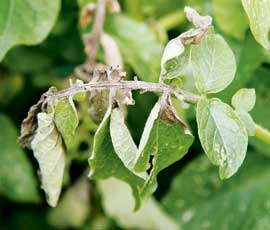Potato genome mapping benefits within a decade

Growers could start seeing the benefits of the potato genome being sequenced within the next decade, with varieties bringing new traits such as PCN resistance or improved tuber shape.
That was the message from Glenn Bryan, leader of potato genetics at the James Hutton Institute, at a recent Potato Council briefing.
Key traits including disease resistance, nutritional value, quality and yield can be identified using information from the mapped potato genome. Plants that have these traits or a combination of these traits can then be included in breeding programmes.
“For example, we already have a good understanding of the genes that affect simple traits such as tuber shape,” said Dr Bryan.
“Using this information, breeders will be able to select parents that they know produce a longer tuber. These parents can then be included in their conventional breeding programmes.”
Longer tubers will appeal to growers supplying the chipping market, who have to meet certain shape specifications.
Understanding traits in varieties that are resistant to potato cyste nematode and blight could also lead to increased resistance in new varieties.
“This of course will benefit the grower and the environment, as less emphasis is placed on the need for chemical controls,” said Dr Bryan.
Marker-assisted breeding can also significantly reduce the time it takes to develop new varieties, as the plant is not required to reach full maturity.
However, added Dr Bryan, the speed at which new varieties are developed based on genomic information is dependant on the uptake of the research by the industry.
“There is little evidence that marker-assisted breeding is being used in many potato breeding programmes at the moment. I would like to think this will change in the next three to five years,” said Dr Bryan.
To get the most from research the potato industry also needed to identify and prioritise the key attributes required in new varieties.
He added that it’s hard for the relatively small scientific community working in potato genomics to meet all the requirements of multiple growers wanting new varieties to have a range of unique attributes.
“Understanding and researching the attributes needed in new varieties would be easier if the industry could decide on the traits new varieties absolutely have to have,” he said.
“The industry needs to work together to identify what traits it really needs, because we can’t work on all of them,” said Dr Bryan.
He sees this as being part of managing the relationship between scientists, breeders and the various industrial sectors.
Key points
• Potato genome sequenced by 2011
• Sequencing carried out by an international team of scientists led by the researchers at the James Hutton Institute
• Marker-assisted breeding to speed up new variety development
• Call for the industry to decide on trait priorities
Marker-assisted breeding
Marker-assisted breeding combines conventional breeding methods with an understanding of the plant’s genome.
Traits such as resistance, yield, shape, skin finish and quality are all defined by the potato’s genome, which was mapped by 2011.
By looking for the markers that indicate certain traits in the genome, scientists can more accurately identify parent plants which have specific traits they want to include in the breeding programme.
The breeding process can also be shortened because genetic information can be collected from young plants and traits identified before the plant has reached full maturity.
Scientists are also able to identify multiple traits in plants, which can then be included in the breeding programme.

